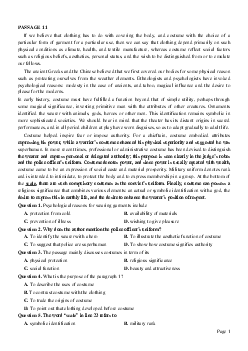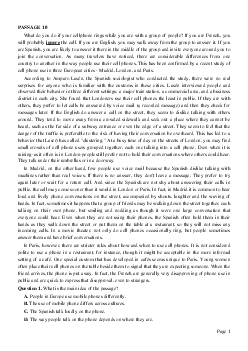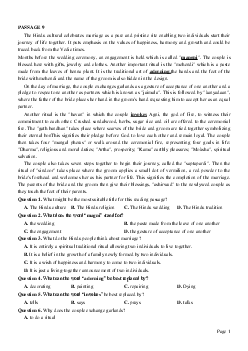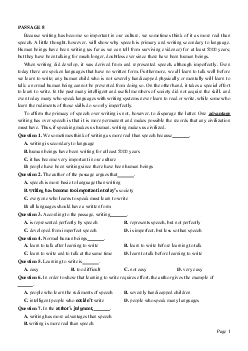


Preview text:
PASSAGE 2
In ancient Greece athletic festivals were very important and had strong religious associations. The
Olympic athletic festival, held every four years in honour of Zeus, eventually lost its local character,
became first a national event, and then, after the rules against foreign competitors had been abolished,
international. No one knows exactly how far back the Olympic Games go, but some official records date from 776 B.C.
The Games took place in August on the plain by Mount Olympus. Many thousands of spectators
gathered from all parts of Greece, but no married woman was admitted even as a spectator. Slaves,
women and dishonoured people were not allowed to compete. Records show that the evening of the third
day was devoted to sacrificial offerings to the heroes of the day, and the fourth day, that of the full moon,
was set aside as a holy day. On the sixth and last day all the victors were crowned with holy garlands of
wild olive from a sacred wood. So great was the honour that the winner of the foot race gave his name to
the year of his victory. How their results compared with modern standards, we unfortunately had no means of telling.
After an uninterrupted history of almost 1,200 years, the Games were abolished in A. D. 394 because
of their pagan origin. It was a great many years before there was another such international athletic
gathering. The Greek institution was brought back into existence in 1896 and the first small meeting took
place in Athens. After the 1908 London Olympics, success was re-established and nations sent their best representatives.
Today, the Games are held in different countries in turn. The Olympics start with the arrival in the
stadium of a torch, lighted on Mount Olympus by the sun’s rays. It is carried by a succession of runners
to the stadium. The torch symbolizes the continuation of the ancient Greek athletic ideals, and it burns
throughout the Games until the closing ceremony.
Question 1. The first Olympic Games took place ,
A. in the 17th century A.D
B. certainly before 700 B.C
C. over three thousand years
D. a thousand years ago
Question 2. At the ancient Olympic Games, any competitor had to be . A. Greek B. male C. unmarried
D. neither a slave nor a foreign
Question 3. The word “that” in line 5 (2nd paragraph) refers to . A. the third day B. the fourth day C. the evening D. a holy day
Question 4. During the Games, on the evening before the moon was full, .
A. sheep and cattle were sacrificed to Zeus
B. all the victors were crowned with garlands
C. olive branches were gathered from a sacred wood
D. the heroes were honoured with sacrificed offerings
Question 5. Modern athlete’s results can not be compared with those of the ancient runners because .
A. details such as times were not recored in the past
B. the Greeks had no means of telling the time Page 1
C. modern athletes are much better
D. official records were lost soon after the Games were abolished
Question 6. The verb “pagan” in line 2 (3rd paragraph) is closest in meaning to . A. Greek B. Olympic C. religious D. sporty
Question 7. The continuity of the Olympic Games .
A. was broken in the year A.D 1200 B. was broken in 1896
C. was interrupted for over 1,500 years
D. was interrupted for almost 1,200 years
Question 8. The phrase “in turn” in line 1 (the last paragraph) can best be replaced by . A. in a sequence B. by chance C. in order D. in time
Question 9. The word “succession” in line 3 (the last paragraph) is closest in meaning to . A. procession B. a number C. process D. marching
Question 10. The modern Olympics compared with the ancient ones are .
A. inspired by the same ideals
B. more restricted in the variety of events
C. different in every respect
D. too much concerned with international rivalry ĐÁP ÁN 1-B 2-B 3-C 4-D 5-A 6-C 7-C 8-C 9-A 10-A
LỜI GIẢI CHI TIẾT Question 1:
B: thông tin trong câu: . No one knows exactly how far back the Olympic Games go, but some official
records date from 776 B.C. Question 2:
thông tin trong câu: Slaves, women and dishonoured people were not allowed to compete Question 3:
C: the evening of the third day was devoted to sacrificial offerings to the heroes of the day, and the fourth day, that of the full moon Question 4:
D:’ the evening before the moon was full’ là ‘the evening of the third day’-> heroes was honoured with sacrificed offerings Question 5:
thông tin trong câu: How their results compared with modern standards, we unfortunately had no means of telling. Question 6:
C: religious= pagan: tôn giáo Question 7: Page 2
C: Thông tin trong câu: the Games were abolished in A. D. 394 because of their pagan origin. The Greek
institution was brought back into existence in 1896 and the first small meeting took place in Athens. (1896-394= 1504) Question 8: C: in order: lần lượt Question 9:
A: a succession= a number of people in order Question 10:
thông tin trong câu: The torch symbolizes the continuation of the ancient Greek athletic ideals, and it
burns throughout the Games until the closing ceremony BÀI DỊCH
Trong Hy Lạp cổ đại các lễ hội thể thao là rất quan trọng và có các liên kết đến tôn giáo rất mạnh mẽ.
Lễ hội thể thao Olympic, được tổ chức bốn năm một lần để tôn vinh thần Zeus, cuối cùng bị mất đi tính
địa phương của nó, trở thành một sự kiện quốc gia đầu tiên và sau đó, sau khi các quy tắc chống lại đối
thủ cạnh tranh nước ngoài đã được bãi bỏ, lễ hội này trở thành lễ hội quốc tế. Không ai biết chính xác Thế
vận hội Olympic bắt đầu từ khi nào, nhưng một số tài liệu chính thức bắt đầu từ 776 trước công nguyên.
Thế vận hội diễn ra trong tháng tám trên vùng đồng bằng của núi Olympus. Hàng ngàn khán giả từ tất
cả các nơi của Hy Lạp, nhưng không có người phụ nữ đã lập gia đình được tham gia ngay cả khi chỉ như
một khán giả. Nô lệ, phụ nữ và người bị hạ thấp không được phép để tham gia thế vận hội. Các tài liệu
cho thấy rằng buổi tối của ngày thứ ba được dành cho các nghi lễ hiến tế cho những những anh hùng
trong ngày, và ngày thứ tư trăng tròn, được đặt như một ngày thánh. Vào ngày thứ sáu và là ngày cuối
cùng, tất cả những người chiến thắng đã được trao vương miện với những vòng hoa thánh kết từ ô liu dại
từ gỗ thiêng liêng. vinh dự người chiến thắng trong cuộc đua lớn đến nôi họ được cho tên của mình để đặt
làm tên năm họ chiến thắng. Để so sánh kết quả của họ với tiêu chuẩn hiện đại, tiếc là không thể có cách nào để làm được.
Sau một lịch sử không bị gián đoạn của gần 1.200 năm, Thế vận hội đã bị bãi bỏ vào năm 394 bởi vì
nguồn gốc tôn giáo của nó. Phải mất rất nhiều năm trước khi lại có một lễ hội thể thao quốc tế như vậy
được tổ chức lại. Các thể chế Hy Lạp đã được phục hồi vào năm 1896 và những buổi họp nhỏ đầu tiên đã
diễn ra tại Athens. Sau Thế vận hội London 1908, sự thành công được tái lập và các quốc gia bắt đầu cử
đại diện tốt nhất của họ đến thế vận hội.
Ngày nay, Thế vận hội lần lượt được tổ chức ở các nước khác nhau. Thế vận hội bắt đầu với sự xuất
hiện tại sân vận động của một ngọn đuốc đã được thắp sáng trên đỉnh Olympus nhờ tia nắng mặt trời. Nó
được mang đến bởi hàng loạt các vận động viên cho tới khi đến đến sân vận động. Ngọn đuốc tượng
trưng cho sự tiếp tục của những lý tưởng thể thao của Hy Lạp cổ đại, và cháy trong suốt thế vận hội cho đến khi lễ bế mạc. Page 3




